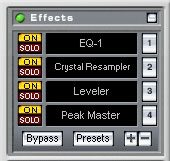

WAVELAB 6 MASTERING PRO
Unlike iTunes and Spotify, Netflix will actually reject your submission if the audio synced with the video doesn’t meet their LUFS requirements.įigure 1: Wavelab Pro 10’s Loudness Meta Normalizer. In this situation, it would make sense to normalize all the tracks on the album to a similar LUFS value.Īnother instance in which hitting LUFS targets is important is when you’re mixing audio for a streaming service like Netflix. Mastering an album is a little different because if one song is hitting -14 LUFS and another is hitting -6 LUFS, that’s a clear sign that the songs have been mixed very differently and although the loudness algorithms they get hit with should normalize them, they’re still going to sound very different from one another.Īlso, if you were to burn these tracks to a CD, the track clocking in at -6 LUFS would sound drastically louder than the -14 LUFS track since there’s no LUFS normalization process that takes place automatically. The whole point of loudness normalization is that your song should sound just as loud as everything else, so there’s no point in maximizing loudness at the expense of audio quality. The normalization processes applied by streaming services will do their thing and there’s not much to worry about. When mastering a single, your best bet is to compress the track to a point that sounds subjectively “good,” then release it as is. There’s definitely something to be said about heavily compressing a song as a stylistic choice, but that’s another discussion altogether. Songs above these values are attenuated, making it pointless to make songs loud for the sake of being loud. Amazon Music, Spotify, and Tidal play back songs at -14 LUFS, and YouTube plays back audio at -13 LUFS. It matches the loudness of all your clips to either the loudest clip you’ve selected, or a target LUFS value.Ĭurrently, Apple Music with Soundcheck activated plays back tracks at -16 LUFS. Wavelab Pro 10 provides a solution to this problem with its Loudness Meta Normalizer feature. Mastering an EP is doable within a basic DAW, but when you’re working on an album containing 12-20+ songs, you’ll end up wasting hours dealing with LUFS levels. Trying to hit target LUFS values across multiple tracks is a nightmare tweaking the settings of all your compressors and limiters is extremely time consuming. If you’ve ever tried to master more than one song in an Ableton or Logic session, you’re familiar with how chaotic the process is. Many engineers charge a flat mastering fee instead of billing by the hour what more incentive do you need to streamline your mastering workflow? 1.

The less time you need to spend mastering, the more masters you can get done. In general, a mastering DAW is going to increase the speed at which you’re capable of producing masters.


 0 kommentar(er)
0 kommentar(er)
